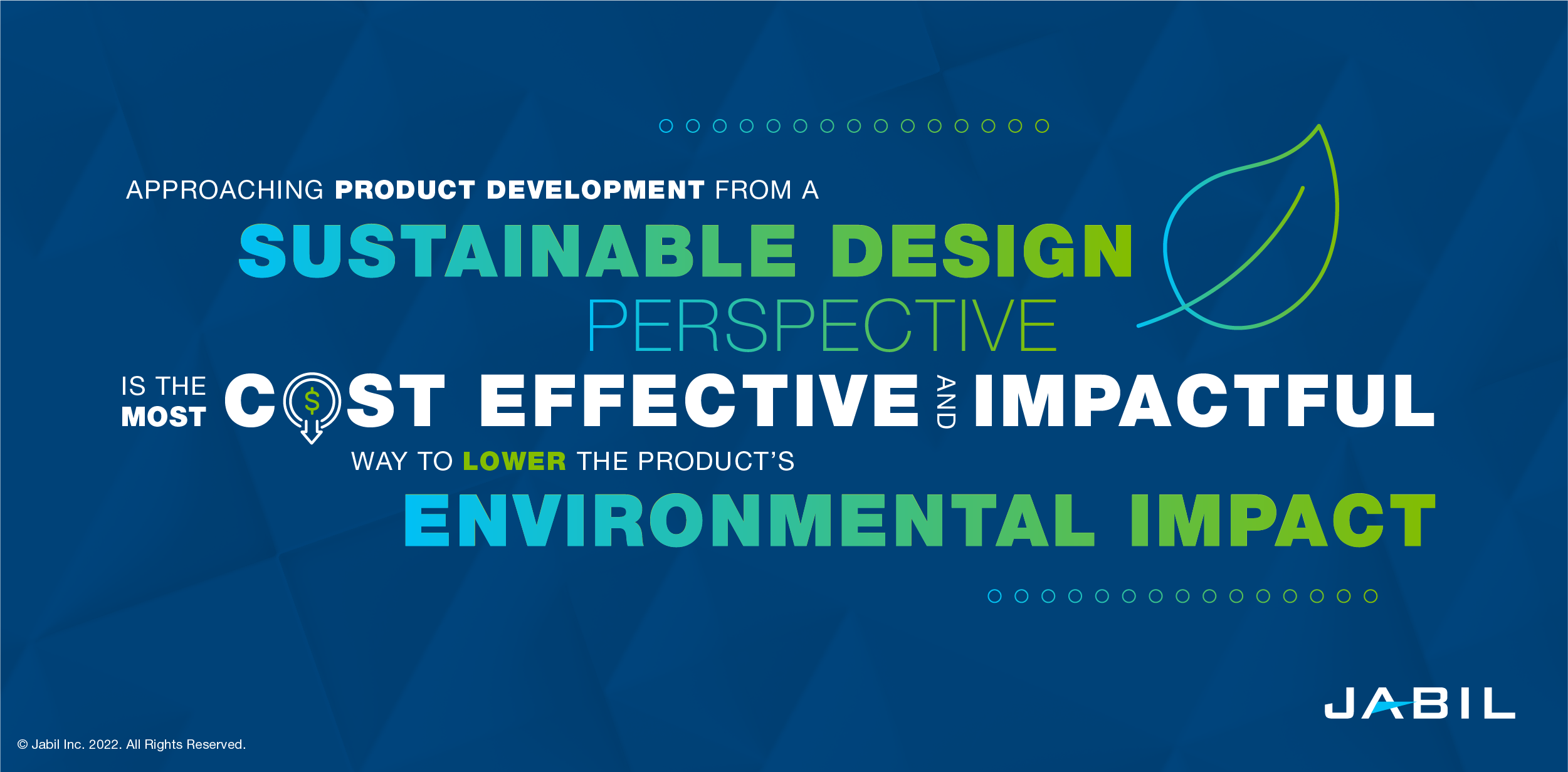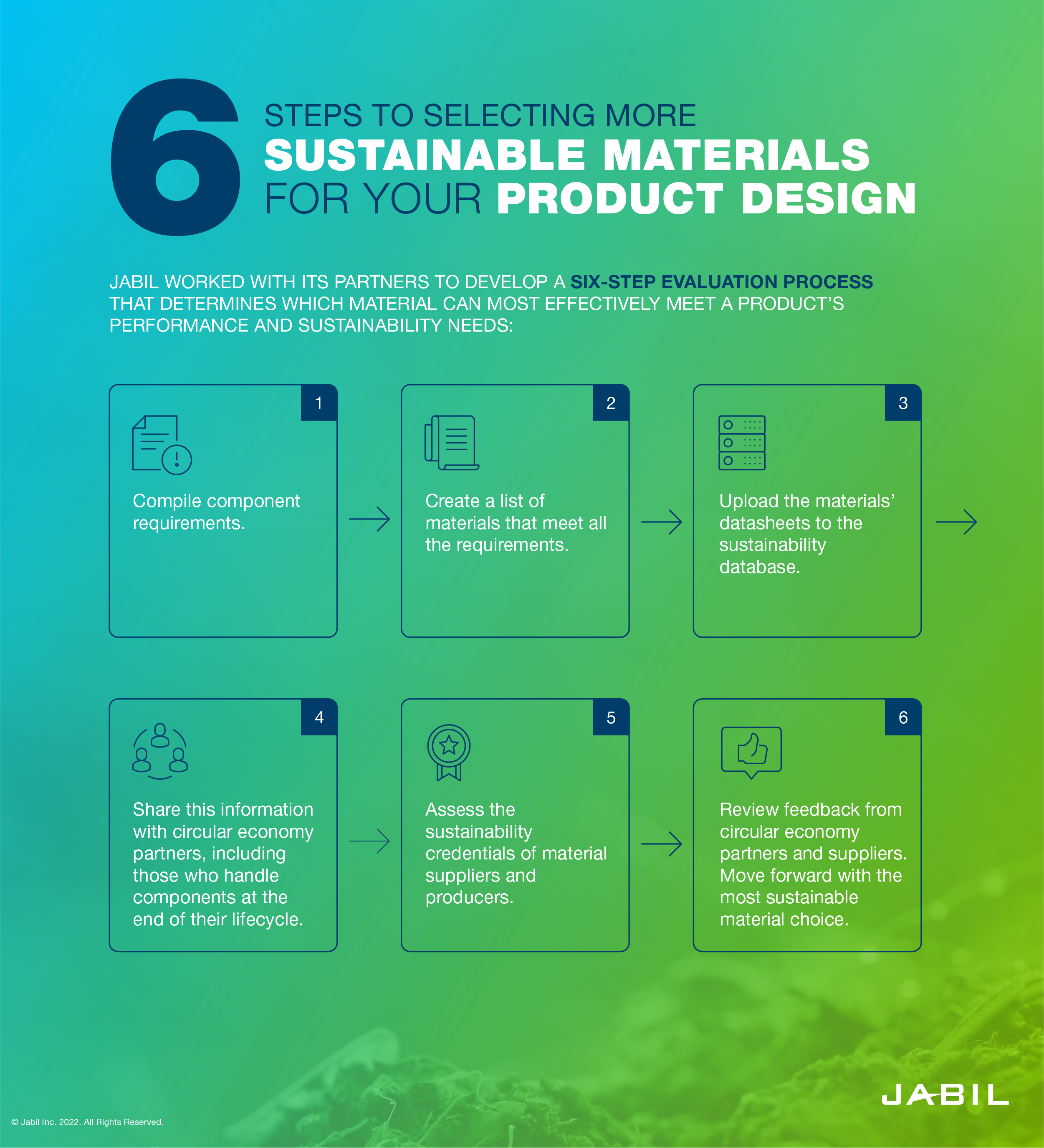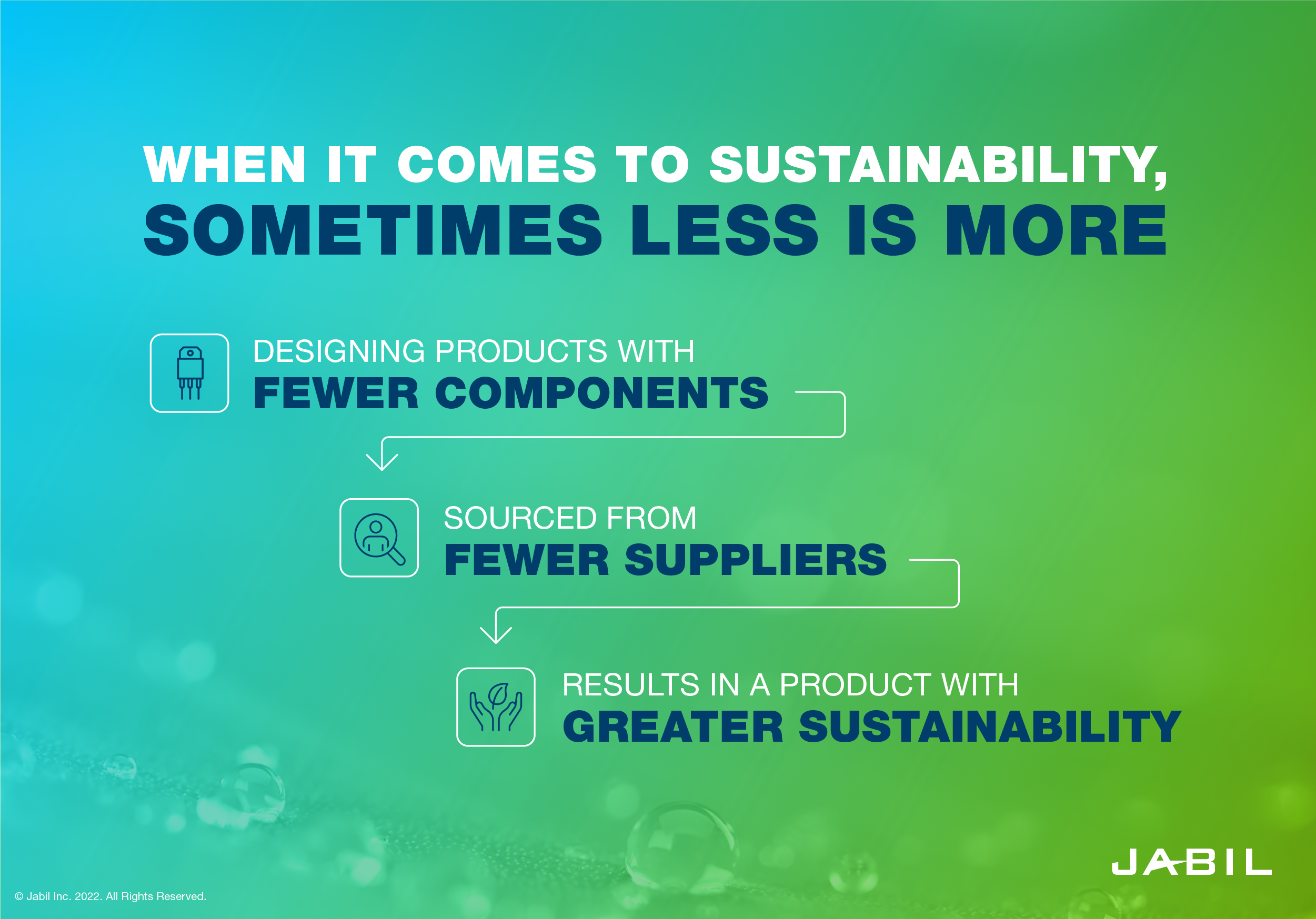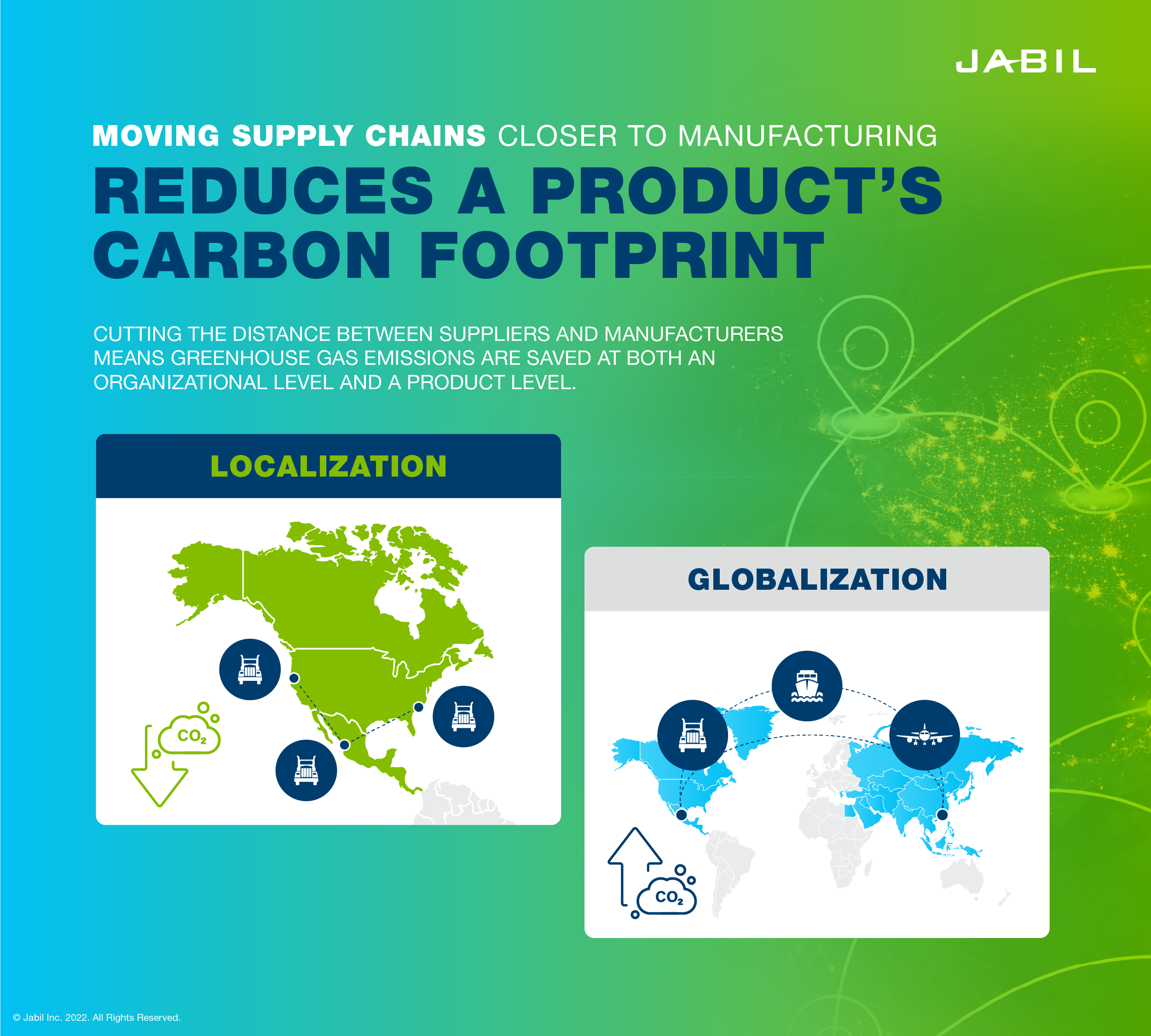Five Ways Sustainable Design Can Reduce GHG Emissions

Historically, new product design has focused on functionality and manufacturability. Some of the discipline's critical areas of focus have included products' ability to be assembled at high volumes and their reliability in the hands of consumers. While those are still critical considerations, sustainable design, or Design for Sustainability, has been added to the list of characteristics a product must possess before it moves to manufacturing. Design for Sustainability (DfS) is a systematic approach to product design that strategically identifies and eliminates areas where emissions are generated by that product throughout its lifecycle; it is a "design for x" process similar to Design for Manufacturing or Design for Additive Manufacturing.
With DfS or sustainable design, the list of considerations include:
- How can the product's carbon footprint be reduced?
- Which materials can be reintroduced to the circular economy or be disposed of in a sustainable way?
- How can manufacturers engage with their supply chain partners to make the most sustainable choices for their product?
It becomes exponentially more difficult — not to mention more expensive and time-consuming — to introduce elements of sustainability into a product once it has already reached manufacturing. Approaching design from its earliest stages with sustainability in mind is the most cost-effective and impactful way to lower a product's environmental impact. According to a 2022 McKinsey analysis, decisions made during the research and development phase of production account for approximately 80% of a product's total resource footprint.

5 Strategies for Sustainable Design
There is not one single swap that manufacturers or product designers can make to create a "sustainable" design. Rather, it takes a holistic evaluation of the design and the processes required to execute it to determine where a product's carbon footprint could be reduced. Here are some strategies to create a more sustainably designed product, from medical devices and consumer electronics to electric vehicles.
Material Selection
One of the earliest decisions made in product design, material selection, can also be one of the most impactful from a sustainability perspective. This is especially true for high-volume, single-use products. By selecting materials that can be recouped at the end of a product's functional life for reintroduction into the circular economy, materials will have a lower carbon footprint overall.
Jabil's site in Bray, Ireland — which specializes in healthcare manufacturing and won the Shingo Prize, the world's highest standard for organizational excellence, in 2021 — is Zero Waste to Landfill certified. All the scrap material produced during the site's manufacturing is processed at the facility and sent off to be recycled into new plastic components. Just as you would normally work with experts in molding or assembly processes early in the design process, engage with partners who have recycling expertise to understand the challenges that exist in the recycling process when deciding to introduce recyclable materials. Thus, designers can design the product lifecycle, including a more sustainable end-of-life plan, around the recycling strategy from the get-go.
Jabil Healthcare has developed an assessment to help determine which materials would be the most sustainable for a particular product. Considerations include:
- Recycling method
- Environmental impact of the material production
- Carbon footprint of the supply chain for the material
- The material supplier's sustainability credentials
- The predicted outcome for the material post-use (i.e. landfill, waste-to-energy, circular economy).

For plastic products that must meet higher performance standards of material traceability to avoid contamination (like medical devices and food and beverage packaging), bio-based resins may be an alternative to recycled materials. For example, there are now sustainably produced medical-grade materials, almost identical to the existing product in terms of performance but made up of 95-100% biocontent. These materials have typically less than 50% of the carbon footprint of the original materials produced from fossil fuels.
Device Disassembly
Design for Assembly is a standard step in the product design process. Design for Sustainability adds Design for Disassembly into the equation. In the past, the priority has been on how the product and its components would fit with the assembly equipment, fixtures, feeding systems and optics systems throughout the manufacturing process. Now, how those pieces will be taken apart for recycling and recovery once a consumer has finished using the product is an equally important consideration.
Manufacturers may need to consider moving away from assembly processes that chemically bond materials and make them more difficult to disassemble, like ultrasonic or laser welding. Conveniently, these are also carbon-intensive processes, so eliminating them from your value chain will help reduce a product's overall footprint. There are other methods to help make products easier to disassemble:
- Avoid the use of lubricants or solvents that can contaminate waste streams and reduce the value of the device as a circular asset.
- Reduce the use of screws or bolts that will make disassembly more time-consuming. If screws are required, ferrous materials are optimal so they can be magnetically separated during recycling.
- Avoid the use of inks or painting of parts that can contaminate whole plastic batches. Consider processes such as in-molded marking or laser marking as alternatives.
- Consider the use of shape memory resins in device clipping mechanisms. These can be designed in such a way as to secure the device enclosure during use but also facilitate easy disassembly by heating the device post-use.
One important consideration is the threshold at which it requires more energy to disassemble the product for component recycling than the amount of energy savings that will be yielded by that recycling. After assessing with your recycling partner, if it becomes clear that recycling is the less sustainable route, it may be optimal to shred the devices and sort the material, rather than the whole components, for recovery. Finally, to create a true, fully owned circular economy, a "global returns" system would bring products back to your site after use for disassembly and recycling, allowing for end-to-end visibility into the whole product lifecycle.
Modular Design
Another significant investment manufacturers are making in product sustainability is incorporating the use of reusable, connected devices to decrease their reliance on single-use, disposable devices. Still, reusable devices generally have some components that are either disposable or that require upgrading after a certain length of time.
For example, Jabil's Qfinity connected autoinjector can be reused over 100 times, and the only component that must be discarded after each use is the prefilled cassette that contains the injected drug. By using modular design for products with both reusable and disposable components, designers make it safer and simpler for component swaps to happen.

WHAT IS QFINITY?
In modular design, reusable and disposable components are kept separate to avoid biohazard contamination (as in a medical device) and/or to make repairs simpler. For example, electric vehicles rely much more heavily on modular design than traditional ICE vehicles. When a customer has an issue that requires repair, the affected module can be removed and quickly replaced — allowing the car to be driven immediately instead of the entire car sitting in the shop because one part needs work. Thanks to modular design, when one component is impaired, the entire device does not need to be replaced or be rendered temporarily unusable while that one component is fixed.
This will require a move toward standardization on the part of brands and manufacturers — increasing the use of standard components and standard tools that can be used to change out those components. "Right to repair" laws and similar legislation are putting more power in consumers' hands to fix, rather than replace, their durable electronic goods over a longer period of time.
Component and Supplier Reduction
In addition to using components made from more sustainable materials, overall product sustainability can also be enhanced by simply reducing the number of components and component types included in a product's design. It is simply more cost effective to have fewer material types to reintroduce into the circular economy, and a smaller amount of overall material in the product means a smaller overall carbon footprint left during transportation, manufacturing and assembly.
One way to accomplish this reduction is through additive manufacturing, so you can print the exact size and shape part you need, even avoiding bonds like screws and glue that can make a product harder to disassemble for recycling. Designs made with 3D printing can incorporate lattice structures and other features that are not feasible with traditional manufacturing.
Another approach to sustainable design is creating products that reduce the number of single-use components that end up in landfills and waterways. For example, solutions like device and consumable systems use durable dispensing devices with refills of home and personal care products like hand soap or laundry detergent. Touchless sensors ensure that just the right amount of product is dispensed to help the refill last longer, while the refill containers can be made from less plastic or alternative, more sustainable materials than traditional product packaging.
While this may be a natural effect of streamlining your product's bill of materials, optimizing the supply chain to reduce the number of suppliers needed for a given product is another way to boost sustainability. By focusing on a smaller number of suppliers who can provide more of a product's BoM, component shipments can be maximized to minimize the number of individual shipments that must be made. Manufacturers can then work more closely with this smaller list of suppliers to improve sustainability throughout the value chain.

Reshoring or Nearshoring Supply Chains
Of course, the smaller the distance between any given supplier and the manufacturer, the smaller the emissions generated by the transportation of components in a product's supply chain. As part of material and component selection in the design stages, consider where potential suppliers are located in relation to manufacturing facilities in end markets.
Once a relationship is developed with suppliers, manufacturers can use that relationship's emphasis on sustainability to dive even deeper into the supplier's own supply chain. Where are they sourcing their materials and components? Are there opportunities to develop a more local supply chain within the country or region? With time and commitment, sustainable design can become a practice that runs throughout your company's entire supply chain.

Sustainable Design Helps Manufacturers Build a Greener Future
Making sustainable design part of the standard product development process can't happen overnight, and there will likely be internal and external hurdles to overcome:
- Implementing sustainable design into the production process is an initial time and financial investment but will likely reap a long-term ROI.
- Sustainability regulations vary from country to country and region to region, so global companies must stay on top of — and even ahead of — these changing rules to maintain compliance.
- Ongoing supply chain challenges make it difficult for organizations to access critical components, let alone those optimized for sustainability.
- Finding ways to reimagine high-impact, in-demand components, like lithium batteries, to leave less of an environmental footprint will be an innovation challenge designers and engineers must face in the years to come.
Still, there's a bigger picture to envision when considering the value of sustainable design. While the adoption of these practices can certainly reduce the environmental impact of individual products, it can also have further-reaching ramifications on your organization's approach to sustainability overall.
Developing a Circular Economy
As we mentioned, sustainable design can make it possible to create an end-to-end production and returns system that allows manufacturers to recoup materials and components in new products. However, sustainable design is so tightly linked to the circular economy because the latter's success is tied to the early implementation of the former.
If sustainable design is considered early in the product development process, manufacturers can create processes for recovering components and materials after consumer use or develop relationships with supply chain partners who can handle that recovery process. Similarly, OEMs can plan for how the recycled materials will be used and ensure they are only capturing materials that will actually have a place in a new product. Otherwise, energy expended to recycle components will simply go to waste. It's critical to understand how material will be captured and where it will go, and the design stage is where you have the flexibility to do that. By waiting too long to design your circular economy, you lose that flexibility.

Sustainable Design Drives More Sustainable Manufacturing Practices
Lifecycle assessments, which gauge the number of emissions generated by a particular product at each stage of its development from cradle to grave, are a necessary part of the adoption of sustainable design. But in addition to determining how those emissions can be reduced through design choices, a lifecycle assessment can also identify other areas where a product's carbon footprint could be reduced, such as manufacturing processes and logistics.
Making more sustainable design choices can also help decarbonize manufacturing as larger OEMs leverage their spend volumes to influence their suppliers and other supply chain partners to incorporate more sustainable practices within their own organizations. As manufacturers look to reduce their scope 3 emissions in particular, it will become increasingly important that they model these decisions for, and ask the same of, companies down the supply chain.
Using that influence also shows an OEM's customers, consumers and employees a commitment to a broader societal goal beyond the bottom line. Making sustainable practices a tenet of operations, educating teams within your organization about sustainability, and collaborating with other organizations within your supply chain so they can do the same, adds value for customers in addition to reaping environmental benefits.
That starts with innovating early and often to take advantage of the opportunities that practices like sustainable design provide. Creating more sustainable products is not something a single organization can, or should, do alone, but by asking the right questions and considering all the possibilities, product design could be just the start of a sustainability sea change.
How can Jabil help you meet your sustainability goals? Contact us.
No matter how complex or demanding the project, we’re helping today’s eco-conscious innovators solve it. Get started with a trusted partner.
